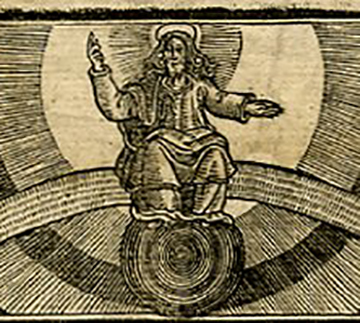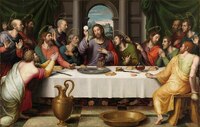Quoting Scripture
Setting Parameters
Young refuses to be taught by these men; however, throughout the examinations she subtly teaches them, asserting her authority in surreptitious ways. In the fourth examination, when Young asks, “Will it please you that I shall declare my faith? And if it be not good, then teach me better, and I will beleeve it” (Foxe 1874). However, Young has already refused instruction twice at this place in the examinations. Later, in the fifth examination, she tells the Bishop’s Chancellor, “Sir, if it will please you to heare it, I will declare [my faith] unto you. But I pray you that you will take your pen and write it, and then examine it, and if ye finde anie thing therein that is not fit for a christian woman, then teach mee better, and I will learne it” (1875). Not only is Young asking the Chancellor to write down and study her words, but also, she is mirroring her own view of faith (as noted in Literacy and Power), which is reading first, then interpretation, then teaching. This is a challenge, cloaked in simplicity. When she states this, the Bishop’s Chancellor notes, “Well sayd,” but asks, “who shall be judge between thee & me?” to which Young replies: “The Scripture” (1875). The Chancellor agrees, and in this moment, Young lays a trap for her questioner. Throughout her three examinations with the Bishop’s Chancellor, Young continually bests him with arguments grounded in scripture; she is able to do this in part, because those were the terms she laid out at the beginning of her first examination with him.
Eviscerating her Examiners
Once her parameters have been set, Young eviscerates her examiners. During the fifth examination, Young and the Chancellor debate a key issue that resurfaces throughout the examinations, which is the sacrament. This ceremony, in which Christians eat bread and drink wine as a symbol of Christ’s death, is a point of contention between Catholics and Protestants. According to the Catholic doctrine, the bread and wine served during communion are transformed into the physical body and blood of Christ, a doctrine called transubstantiation. However, Protestants argue that the bread and wine are simply a spiritual reminder; as Young states, she “receive[s] his sacrament in faith and spirit” (Foxe 1874). During the exchange found in the fifth examination, Young quotes from Matthew 26:27, and Luke 22:17, saying Christ “tooke the cup and gave thankes to his father, and gave it unto his disciples, saying: Drinke ye all hereof: for this is the cup of the newe Testament in my bloud which shall bee shed for many” (Foxe 1875). Young continues, “Now I pray you sir, let mee aske you one question: Did hee give the cuppe the name of his bloud, or else the wine that was in the cup?” (1875). Young cunningly plays with the words of scripture to make her argument. This passage, according to Catholic belief, is Jesus confirming that the eucharist is transformed into Christ’s literal blood during the sacrament. Young mocks the literality of this concept by suggesting that Christ was never referring to the wine, but rather the cup he was holding.
Shortly after, Young makes three important points about eucharist: Firstly, she points out that eucharist is done “in remembrance,” of Christ, and therefore, “is not of a thing present, but absent” (1875). Secondly, she notes that eucharist is done to “shew forth the lords death til he com,” and therefore “we may not looke for him here, until his coming againe at the latter day” (1875). Lastly, she states that Christ “sitteth at the right hand of God the father almightie: from thense he shal come to judge both the quicke and the dead,” and so “if he shall not come, before he come to judgement, then how is he here present in your sacrament of the altar?” (1875). Here again, using the language of the scripture, Young formulates her clever arguments.
“Sir, true it is, and I trust that I sayde nothing that yee can denie by the Scriptures” (Foxe 1876).
After making these points, the fifth examination abruptly ends. At the beginning of the sixth, the Chancellor states: “woman, the last time that thou wast before me, our talke was concerning the sacrament,” to which Young, ever to the point, replies “Sir, true it is, and I trust that I sayde nothing that yee can denie by the Scriptures” (1876). Here, we see the fruition of Young’s verbal trap, laid at the beginning of the fifth examination.
The Crux of the Argument: Young's Ninth Examination
Although Young employs her clever rhetoric throughout her interrogations, the ninth examination, is the culmination of Young’s debate strategies. Here, Young is being interrogated by the Dean of the Catholic church. Once again, they are discussing sacrament:
[Deane.] What doest thou receive when thou receivest the sacrament which Christ left among his Disciples the night before he was betrayed?
Eliz. Sir, that that his Disciples did receive.
Deane. What did they receive?
Eliz. Sir, that that Christ gave them, they received
(1877)
Here, Young replies with ambiguity, carefully choosing words that appease the Dean without compromising her faith. Again, the Dean asks,
When thou receivest it, doest thou beleeve that thou receivest his bodie?
Eliz. Sir, when I receive it, I beleeve that through faith I doe receive Christ.
Deane. Doest thou beleeve that Christ is there?
Eliz. Sir, I beleeve that he is there to me, and by faith I doe receive him
(1877)
Here, although the Dean gets more specific, Young still manages to remain ambiguous. Although he is asking if she physically receives Christ’s body, Young maintains that she does, but also slips in the modifier “by faith,” which could mean simply faithfully, or, could mean spiritually. A third time, the Dean asks, “When thou doest receive it after the institution that Christ ordained among his Disciples, the night before he was betraied, doest thou beleeve that Christ is there?” to which Young answers, “Sir, by faith I beleeve that he is there, and by faith I doe beleeve that I doe receive him” (1877). Here again, the key word in this exchange is “faith.” Lastly, the Dean says, “Now thou hast answered mee. Remember that thou saiest, that when thou doest receive according to the institution of Christ, thou doest receive Christ,” to which Young replies, “Sir, I beleeve Christ not to be absent from his owne sacrament” (1877). Importantly, she states that Christ is present at his own sacrament, but she does not state when, or in what form. With this, the Dean is satisfied, saying “Why, thou Calfe, why wouldest thou not saie so to daie?” (1877). Young replies, simply, “Sir, ye asked me no such question,” (1877). Interestingly, here it is exactly the kind of careful, discreet language encouraged by Robert Braithwait that allows Young to circumvent the questions. In The English Gentlewoman, Braithwait notes that “Silence in a Woman is a moving Rhetoricke” (90). Young employs near silence here, speaking just enough to answer the question, but not so much that she might condemn herself.

